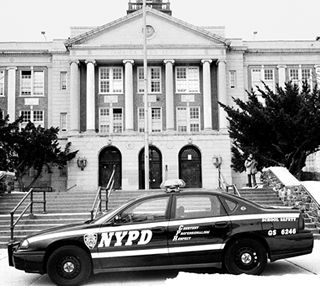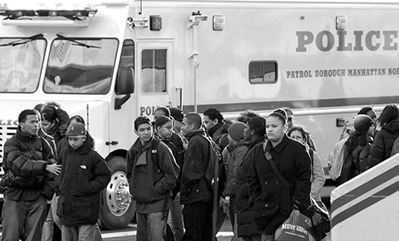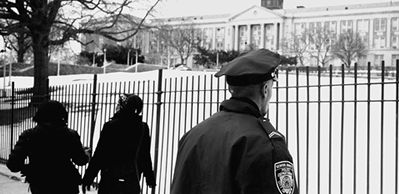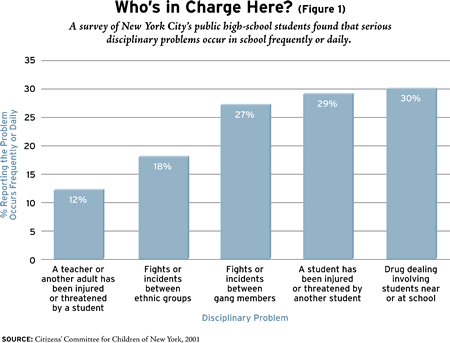 |
| Jamaica High School in New York. Photographs by Patrick Harbron.
|
At the height of the baby boom, Jamaica High School in Queens, New York, enrolled approximately 5,000 students, who attended school in triple session. Each cohort of students had to start and end school at a different time in order to maximize classroom use. There were only two or three deans to address disciplinary issues, and a lone patrolman stood watch in the lobby of the school. It was assumed that a large portion of the school’s graduates would go on to college, while the rest would become society’s secretaries, plumbers, carpenters, printers, and butchers. Although Jamaica High was considered one of the school system’s academic gems, it also provided vocational training that has long since disappeared.
Today the school population has been sliced to 2,500, yet Jamaica High now has eight deans (myself included), who devote much of their time to disciplinary issues; an assistant principal for security; two secretaries, one part time, one full time; and a school aide assigned just to the dean’s office. In addition, ten school security agents employed by the New York City Police Department patrol Jamaica’s halls. The number increases on those days when “random scanning” of students for weapons is in effect.
Schools Under Siege
The extra personnel alone do not even begin to account for the costs of attempting to maintain discipline and safety in the school. Consider the following tales from Jamaica High. In one instance, a teacher saw a student take a gun from his locker and show it to other students. He informed the security agent, who in dereliction of his duty did nothing. Then the teacher came to the Dean’s Office, and I immediately began looking for the student. But the student had fled the building. When he returned two hours later, the police searched him and found nothing. The superintendent was informed, and an investigation of the event proceeded. The student claimed that he had no gun. When asked why he had exited the building, he claimed that a security agent had thrown him out. He could not identify the agent by sex or by race.
Statements were taken from students who had seen the gun, the student’s parents were notified, and a hearing date was set. For the teacher and me to attend the hearing, substitutes had to be hired to cover our classes. At the hearing, after waiting for two hours, we received word that the parent had asked for a postponement by making a telephone call, which was within his rights. It was the end of the school year, so the case was carried over to the next fall. The postponed hearing was scheduled for September 13, which wound up being just two days after the horrible events of September 11. As I walked to the offices located near Madison Avenue and 22nd Street in downtown Manhattan, an acrid stench hung in the air, even though I was some distance from Ground Zero.
At the hearing, the parent of the accused asked me a very good question: Why had we allowed his son back to school if we believed that he had a gun? His son had rights, I said. And it took a couple thousand dollars’ worth of personnel hours to protect them. The hearing officer eventually found in our favor, and the student was transferred to another school.
In another instance, a learning-disabled student in a mainstream class asked a teacher for a hall pass. When the teacher refused to give it to him, the student called the teacher, who had badly injured her hand in a car accident, a “crippled bitch” and threw an object at her. A security agent who had witnessed the event removed the student. The superintendent was informed, and the student’s home was contacted. The next day I confiscated the hand of a store mannequin that the student was carrying around with him. He said he wanted to show the teacher that “he had a hand like hers.” At 16 years of age, the student had earned just one of the 40 credits needed to graduate.
The teacher, the security agent, and I had to appear at the hearing. Again, substitutes were provided to cover our absences. And again, the hearing was postponed, this time at the request of a man who called himself the student’s “grandfather.” Even though he turned out not to be the grandfather, the hearing officer accepted him as the advocate because he brought a letter to that effect signed by the mother, with whom I was never able to speak.
At the next hearing, the “grandfather” asked the teacher, “Do you consider yourself crippled, because if you do, then you are in fact a -crippled bitch,’ and the charges should be dropped.” The hearing officer did not agree and found in the school’s favor. However, the student fell under the protections of the federal special-education law because of his diagnosed learning disability. As such, he was allowed to return to the school premises immediately. After several more suspensions, school authorities were finally able to get him transferred to one of the school system’s “second opportunity schools,” or “SOS” for short.
Multiply this case by thousands, and you will have some notion of the problem of maintaining safety in the city’s schools (see Figure 1). State and federal court decisions intended to protect the rights of students, followed by the schools’ attempts to comply with the mindless bureaucratic directives used to implement these rulings, have made it all but impossible to expel a student unless a flagrant felony is committed that results in the student’s incarceration. As a result, our halls are filled with students who cut nearly all their classes on a daily basis, whose only contribution to the educational process is to harass other students and make it necessary to maintain a phalanx of security officers at the school.
At a large high school like Jamaica, the demands of the school day make it nearly impossible to give these deeply troubled kids the kind of individual attention and support they need. They slip through the cracks and wind up disrupting not only their own education, but also that of the students around them. The schools need to be made safe for education, and those who bring chaos to the school environment need alternative education settings, where teachers and counselors can work with them and their families on a more one-to-one basis. This is especially true of students who have committed criminal acts in or outside of school. The New York City Department of Education took a step in the right direction in February 2003, when officials announced plans to open 17 “New Beginnings” centers for students with the most serious behavior problems. However, these centers will accommodate only a fraction of the students who require placement, and red tape has delayed their opening.
Often these children can be targeted for help merely on the basis of their academic progress, but they rarely are. Our worst discipline problems usually present our biggest educational challenges as well. In almost every instance, an investigation of a serious disciplinary infraction reveals that the student has made little or no academic progress. For students who enter high school unable to read, the game is up unless they are identified and placed in an alternative learning environment outside of the high-school setting. Once inside the large New York City high school, they become lost to everyone except the police and the deans.
 |
| A sizable portion of the student body regularly cuts class and keeps school safety and the academic deans at bay on a full-time basis. Photograph from AP World Wide.
|
Fuzzy Math
It is impossible to account for the pedagogical costs such students exact on the schools: the classroom disruptions, the harassing of other students, and the frustrated new teachers who leave the profession. And the New York City Department of Education has not even attempted to tally the financial costs. Indeed, nobody knows how much of the city’s $12 billion-plus annual budget is dedicated to school safety. But we do know that a significant portion of the funds that are earmarked for instruction and administration is actually used to maintain security.
There are approximately 150 high schools in the New York City school system, and a significant share of them house more than 2,000 students. High schools increasingly make security the sole responsibility of an assistant principal, which is supposed to free the school’s principal to focus on instructional leadership. The responsibility for the day-to-day enforcement of each school’s disciplinary code falls to the dean’s office. School deans, whose number varies from school to school, usually teach only two classes a day. Yet at Jamaica High, the salaries and benefits for the eight deans and three-person support staff assigned to school security are treated as part of the instructional and administrative budget. Another 14 school aides are stationed in the cafeteria, outside bathrooms, locker rooms, and halls, in what can certainly be described as security-related assignments. At least $1 million in salary and benefits is devoted to school safety at Jamaica High alone—and that does not include the cost of the ten school safety officers, who are paid through a separate contract with the Police Department.
The situation is routinely aggravated by administrative decisions that fail to recognize the realities of everyday school life. For instance, schools can administer one of two kinds of suspensions, the “principal’s suspension” and the more serious “superintendent’s suspension.” However, the principal’s suspension was rendered essentially useless when the previous schools chancellor, Harold Levy, ordered that the suspension be served “in house.” This was abetted by new state regulations requiring that suspended students not have their education interrupted.
Before Levy changed the rules, the principal’s suspension was an effective tool because it kept an unruly student out of the building until at least one of the student’s parents accompanied the student to a conference with the principal, the dean, and the guidance counselor. Students prone to misbehaving would think twice if their mother or father had to take off from work to get them readmitted. It also gave school administrators the opportunity to discuss the incident, and usually the student’s general lack of academic progress, with the parent. The same conference is supposed to take place after an in-house suspension, but with the student already in school, the parent would often refuse to show up. The principal’s suspension effectively withered as our first line of defense.
The granting of a superintendent’s suspension hearing allows the student charged with an offense to call and cross-examine witnesses, postpone, and of course appeal the decision. The hearing is held in a special facility with a hearing officer, the dean of record, the victim or victims, witnesses, and a technician who transcribes the testimony. Before the New York state commissioner of education forbade it, students who had charges sustained against them in such a hearing would be moved to another school automatically. Under current policy, if the school believes the student represents a serious threat to the school population, it must initiate an involuntary transfer procedure, involving another round of reports and hearings before the student can be removed. This is essentially a game of musical chairs, only with a guarantee that when the music stops everyone is left with a chair. Should the case involve a “special needs” student, a finding must be made that the offense was not related to the disability. If the disability is ruled to have been a contributing factor, the student is returned to school without consequence.
For instance, one student was hearing voices and stalked a teacher, who had an order of protection issued. The student turned out to be schizophrenic and was removed as an EDP (emotionally disturbed person) on four separate occasions over two years. The father refused to have him institutionalized, despite the recommendation of the school psychologist. He was readmitted again and again. He eventually left the school, much as hundreds of students do each year, just disappearing into the ether without our ever knowing where they wound up. The point is that sizable populations in need of close supervision for a host of problems that often have nothing to do with education are simply left adrift in large city high schools. When their behavior becomes truly disruptive, the system responds with a stream of procedures that expends endless man-hours and appropriates uncountable treasure, often without anything to show for the effort.
 |
| At least $1 million is devoted to achool safety at Jamaica High—and that does not include the cost of the ten school safety officers, who are paid through the Police Department. Photograph by Patrick Harbron. |
The Hard Cases
In dealing with the more dangerous members of our student population, the system attempts to ensure safety by disrupting their pattern of behavior. Expulsion is no longer an option, so this is accomplished by using the lengthy involuntary transfer procedure to move the disruptive students to other locations. Eventually, however, cliques of students involuntarily transferred to other schools meet up once again. One is reminded of the film Escape from Alcatraz, where Clint Eastwood reconnects with his old cellmates from Joliet and plans his escape from “the Rock” along with them. Recently, the mother of a student who was new to the school called to tell me that her child had been robbed of her new leather coat after getting into an after-school fight with a group of students on Jamaica Avenue. The next day I asked the student, “How were you able to find yourself fighting with another group of students on your very first day?” She said that she had linked up with a bunch of fellow involuntary transfers from Franklin K. Lane High School, who began feuding with girls from Jamaica High. Why we would expect such students to perform any better simply by transferring them to yet another large high school is beyond me.
Since students must be given a fresh start, schools receiving transfers are not informed of the reasons why a new student has been placed in their midst. Even worse, the schools are not informed of arrests outside the school, so felons are admitted without our knowledge on a regular basis. Last year, I spent two months trying to track down a student who had committed a school infraction, only to learn that he had been discharged after 20 days of continuous absence. He was on Riker’s Island, awaiting sentencing. Later, after being placed on probation for armed robbery, he was readmitted to Jamaica High. Court decisions and school regulations have ensured a safe haven for some truly dangerous criminals in our schools. Should a student be arrested in school, he can come back the very next day and await the results of school disciplinary action for several days afterward.
In a similar vein, the schools are mandated to educate children who have been removed from their homes by the courts and placed in group homes within our zone. Often they are the victims of the most horrific domestic circumstances. Placed in a school of 2,500 students, in the middle of a school term, what are the odds that they will successfully adjust? In November 2002, the director of a group home informed me that three of her charges had robbed another student and asked me if I wanted them arrested. When I asked her why they were placed at Jamaica, she informed me that there were no other options.
At any given time a high school of 2,000 or more students will have 300 to 400 students who have made no academic progress over the course of two years. A percentage will be passive and simply go to class and fail most of their courses. But a sizable portion will cut class regularly and keep school safety and the deans at bay on a full-time basis. With no high-quality alternative settings to send them to and no power to eject them from the premises, the school safety officers find themselves either herding them into classrooms or bonding with the worst offenders in a sort of reverse “Stockholm syndrome.”
Snowballing
The loss of building control did not happen overnight. Decisions made on a case-by-case basis usually made sense, but when compounded with other “plausible” solutions, they incubated like one of those mysterious building molds that render a structure uninhabitable. For example, high schools used to have a homeroom at the start and end of the school day. On entry, students would lock up their coats and be marked present. At the end of the day, they would report to the room again and get their coats. Especially during the winter, this would help to control the building. Students could not simply walk out if they felt like it or flee if they were in trouble. School authorities could readily spot an intruder wearing a coat while everyone else was in shirtsleeves. It was also a good way to eliminate the problems of coats’ being stolen and endless confrontations over the wearing of hats and gang-related paraphernalia. During the 1990s, however, the city’s teacher union, the United Federation of Teachers (UFT), argued that forcing teachers to supervise homeroom was unprofessional. The union was able to get this effective building-control tool abolished through contract negotiations.
Take another example. School aides were put in charge of supervising the cafeteria after the UFT successfully argued that teachers should not have cafeteria duty. Even some of the severest critics of the UFT agreed that it was a waste of teachers’ time for them to be policing the cafeteria. However, teachers knew the students, and the students knew that they knew them. The teachers could keep students in line in a way that school aides never could.
In one fell swoop, the cafeteria became student-gang turf. In Park West High School, a separate cafeteria had to be created for freshmen because they were falling prey to upperclassmen. Naturally, the cafeteria has become a fertile breeding ground for conflict and disorderly behavior that bubbles up daily throughout the school. Students had at least a dose of respect for the school deans and teachers who used to manage the cafeteria. School aides, by contrast, are easily intimidated by students. It is a rare school aide who will confront gang-affiliated students without fear of retribution.
Not only the teachers but also frequently the parents of disruptive students are shocked by the laxity of the school system. My first superintendent’s suspension hearing involved a freshman accused of threatening a female teacher who simply asked him to take his seat and stop cursing. He responded by overturning a desk as he walked toward her, stating he was “going to f— her up.” He was charged with threatening and menacing. The charges against him were sustained, and afterward his mother decided to return him to Trinidad, where the young man was from. When she returned to school to retrieve his records, she informed me that in Trinidad, her son would never have dared to threaten a teacher, and if he did . . . She did not complete the sentence. I would experience this sentiment time and again. Parental disbelief at the level of tolerance for this kind of behavior is palpable. Yet the only response from policymakers and the courts has been the erection of a costly system of adjudicating, tolerating, excusing, and ultimately ignoring deviant behavior.
Those strolling past the library at Jamaica High School can view the plaques honoring the school’s alumni who gave their lives for their country during World War II. Pictures of students, faculty, and athletic teams also adorn the walls. The picture-taking stops sometime during the mid-1970s though. It is as if a geological age had been preserved in a stratified layer of sediment. There was a time, it seems, when the school had a culture and a sense of spirit that invited displays of unity and pride. Something quite meaningful appears to have been lost in the decades since.
Statistically, Jamaica High School falls squarely in the middle of the school system. Learning takes place, and good kids get educated by good teachers, but the presence of a permanent class of “students” who cannot function in this setting continually destabilizes the learning environment, tempts marginal students to behave badly, and squanders untold treasure for no good reason.
-Marc A. Epstein teaches history and serves as an academic dean at Jamaica High School in Queens, New York.



